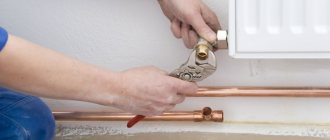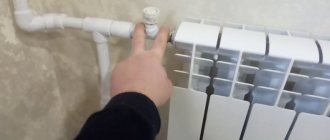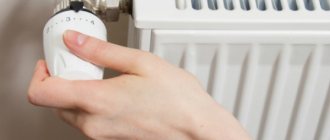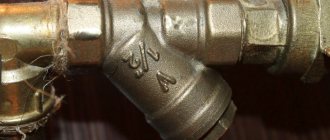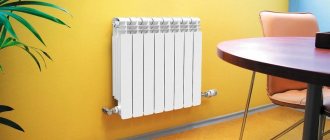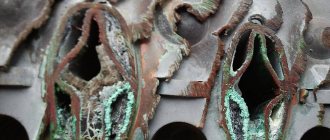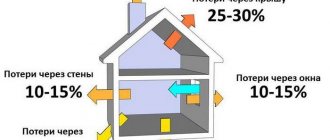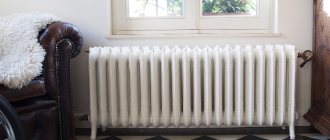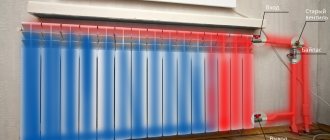The battery is clogged
The formation of a blockage in a heating device is one of the most common causes when the bottom of the radiator is cold and the top is hot. The reason is the insufficient quality of the thermal fluid. The water supplied to the heating system often contains impurities, which, under the influence of high temperature, form into plaque that accumulates on the inner surface of the radiators.
The result of the blockage is a disruption in the movement of the heated coolant through the radiator and its uneven heating. To eliminate circulation problems, you can use mechanical and chemical methods to clean the radiator. In the most difficult cases, specialists often use hydrodynamic and hydropneumatic methods, as well as highly effective electro-hydropulse cleaning of batteries.
Troubleshooting
If you find that your radiator is hot on top, but much colder on the bottom, then you should look for the reason. To do this, you need to perform a number of actions:
- Check the radiator connection. Have all the requirements been met when connecting the heating system?
- Bleed and clean.
- Check the condition of the control valves.
- Check the condition and connections of the pipes.
- Check the circulation pump. Replace it if damaged or install it.
If the pipes were not connected correctly, the bottom pipe will be hot. In this case, it is necessary to disconnect the pipes and reconnect them, but in the correct order. It will also be necessary to establish a work plan. If the pipes were routed correctly, the lower pipe will be slightly warm. In this case, there are no problems with connecting the pipes.
A common cause is the occurrence of air locks in the radiator. To avoid this problem, a special vent must be installed to remove air. You should shut off the supply, open the vent and remove the air. Then you need to turn off the tap and turn the heating valves.
If you do not have a circulation pump or it has low power, then the pressure in the heating system will be weak. And, therefore, the water will move slowly through the radiator. In this case, you need to purchase a powerful circulation pump.
If the heating system is equipped with a control valve, then this may be the cause of the problem. It needs to be removed and checked. If the cross-section is narrowed, you can increase it using tools. Or even replace it with a new faucet. After this, you can reinstall the element.
If none of the reasons listed above are a problem, then you should check the condition of the pipes. There may be various contaminants that need to be cleaned. If the pipes are severely damaged, then you need to buy new pipes.
After studying the article, you can independently identify the cause of the problem. After a thorough inspection of the radiator and elimination of the problem, you can establish high-quality operation of the heating system.
There is air in the radiator
An air-filled heating system is also ineffective in heating rooms. As a rule, such an unpleasant situation with the accumulation of air bubbles in radiators is observed in apartment buildings on the upper floors, which is easily explained by the elementary laws of physics - air rises towards the roof. Usually such batteries have a cold top, but this does not exclude the fact that there may also be a cold bottom.
For preventive purposes, standard Mayevsky taps are installed, through which all the air accumulated in the radiators is drained from the system. You need to shut off the hot water supply pipe and leave the “return” in the open position, then open the tap and let out the air. After closing the tap, the supply of coolant to the radiator is resumed.
What to do if the engine overheats
First of all, it should be remembered that if the overheating is short-term (for example, the temperature needle rises in a traffic jam), then you should observe whether the temperature will drop after you start driving (counter air flow appears) or as a result of turning on the radiator fan.
Read also: White women's sneakers with a dress
If the car was already in motion and the engine temperature reached a critical level, you should not immediately turn off the engine. Also, you should not try to cool the engine by pouring water on it from outside, pouring cold water into the radiator, etc. Such actions will lead to the need to repair the internal combustion engine, and it may be necessary to change the BC and cylinder head.
To “cool down” the engine, you will need to pull off the road (if possible), stop the car and then turn the heater on to maximum, while the engine must continue to idle.
Next, you need to wait a few minutes, while simultaneously inspecting for obvious and strong signs of antifreeze/antifreeze leakage under the car or in the engine compartment. If no leaks are visible, but the temperature does not drop, the unit must be turned off.
Please note that you need to immediately turn off the engine when steam starts coming out from under the hood; traces of intense coolant leakage are clearly visible. In this case, the engine must be stopped, without expecting that turning on the stove will reduce the heating
https://youtube.com/watch?v=0swgbqh-RkU
Battery not connected correctly
Another very common situation of cold bottom and hot top of the battery is its incorrect (unprofessional) connection. Particular attention when organizing a heating system will require the installation of a bypass in front of the heaters, the correct choice of connection diagram and proper installation of all shut-off valves.
The best option would be a parallel (diagonal) connection with a coolant supply at the top and a “return” at the bottom. In addition, it must be remembered that there must be the necessary space at the top and bottom of the battery to ensure normal and stable air exchange. Otherwise, the operation of such a device will be completely ineffective and problematic.
Clogging
The most common reason for this phenomenon is clogged radiators. Here are other reasons why there is a strong temperature difference in the battery: low quality coolant and air getting inside.
This phenomenon can also be affected by the liquid inside the radiator, since it contains various solid particles. While the heating season is just beginning, excess elements may be present in the water, which makes its quality terrible.
If there is an individual heating circuit, then the water will not have such disadvantages.
Why can air affect the temperature at the top and bottom of the battery?
- Because special bacteria are involved that can only live in an environment saturated with oxygen.
- Such bacteria are also called anaerobic.
- Microorganisms themselves do not cause harm to the radiator.
- The damage is caused by their waste products, which settle at the bottom of the radiator as sediment.
Also, silt can settle at the bottom, which gets there from the entire heating main.
Another reason is the special design of the heat exchanger. Because of this, there are places in its shape where dirt accumulates.
Low temperature
If the difference in the temperature conditions of the bottom and top of the batteries is not too significant, then there is no need to worry. This arrangement of radiators is quite natural. The circulating coolant always has time to cool down a little, which is due to fairly high heat output rates. Very large discrepancies may require system intervention.
If the water temperature in the heating system is low, then it will be necessary to increase the heating of the coolant by increasing the power of the operating heater. A good result is also achieved by using a special heat-reflecting screen. For this purpose, it is recommended to use traditional aluminum foil or modern and reliable material such as penofol.
An important point with a two-pipe connection is the ability to regulate the temperature in a separate battery using special fittings, represented by a conventional shut-off valve. This ensures an increase or decrease in the volume of coolant in each radiator by adjusting the shut-off valves.
What to do
If the radiators are barely warm or there is no heat at all in the apartment, then you will need to send an application to the management company with a request to measure the temperature. The application must be drawn up in two copies, one of which remains with the owner.
The application will need to include the following information:
- name of the director of the management company;
- information about the applicant: full name, residential address, contact details;
- information about the owner of the property and details of title documentation;
- description of the circumstances: when the temperature dropped, what temperature indicator was observed at the time of drawing up the application;
- requirement to recalculate utility bills and compensate for losses incurred within a specific time frame;
- list of attached documentation;
- date of preparation of the document, signature of the applicant and its transcript.
The document can be in written or printed form.
The following documents are attached to the application:
- acts and certificates that confirm the information specified in the application;
- receipts for payment of utility bills, which prove the fact that the applicant has no debts to pay for services.
If the representative of the management company refuses to accept the application, then the documents must be sent to the company by registered mail with notification and a list of attachments. The date of receipt of the letter is the moment when the management company employee receives it.
If the radiators are really cold in the house or only slightly warm, then within a week the management company should correct the temperature violations. For all those days during which poor heating was observed in the multi-storey building, the company must recalculate for the residents. For this purpose, a corresponding application is sent to the EIRC.
The application for recalculation will require the following information:
- addressee's name;
- information about the applicant: full name, residential address, contact details;
- the basis for recalculating payment for a specific service (non-compliance with thermal conditions) indicating the date and time when the deviations were documented;
- please transfer the recalculation indicating the period;
- consequences if the Criminal Code refuses to satisfy the applicant’s demands, indicating the relevant legislative norms and requirements (fines, penalties);
- list of attached documents;
- date of application, signature of the person applying.
Corrections and erasures in the application are unacceptable. It is recommended to compose the document electronically and then print it, since it will no longer be possible to correct erroneous data. Some people prefer to call the management company staff for advice on drawing up an application.
For every hour of non-functioning heating, the cost decreases by 0.15%. For every 3 degrees decrease in temperature, the cost decreases by 0.1% per hour.
Low coolant speed
Insufficient coolant velocity directly depends on the design of the heating system, the characteristics of the coolant, the power and performance of circulation pumping equipment, pipe material and diameter.
Optimal indicators:
- private households and apartments - 0.5-1.5 m/sec;
- production premises - within 3 m/sec.;
- administrative buildings - within 2 m/sec.
The speed of movement of the coolant in pipeline heating systems is taken in accordance with the permissible equivalent sound level in rooms for various purposes. When the power of the pumping equipment is reduced, the movement of the coolant slows down, which has time to cool down and the last radiators warm up worse. As a special case, the bottom can be cold and the top of the radiators hot. In this case, it is necessary to increase the power indicators of the device, which will ensure not only faster circulation, but also the most uniform heating of the radiators.
Why is the bottom of the battery cold and the top hot? — School on home insulation
Often on construction forums people complain about heating systems - the bottom of the radiator is cold and the top is hot. It is worth noting that any radiator on top is warmer than on the bottom, but if the gap between these temperatures is too large, then most likely there is something wrong with the system. Moreover, this means that the battery produces less thermal energy than it should. After all, everyone knows that the efficiency of heating devices directly depends on the uniform heating of their surfaces.
Today we will try to figure out why this phenomenon occurs and what needs to be done about it.
Reason. Cold
There is another possible reason why the bottom of the battery is cold and the top is hot. This can happen in the cold. This can happen if, for example, the heating battery is located in a cold room - on a loggia or, alternatively, in a veranda. And if the air in the room is cold, then the working fluid, accordingly, will cool much faster. Because of this, the bottom of the radiator may also have a lower temperature.
Is there any way to fix the problem?
All that remains is to talk about the most important thing - that is, how such problems are eliminated. First of all, we note that the specific decision depends solely on the reason for which everything happens.
If, for example, the lower pipe of the battery is also cold, then, most likely, during installation the “return” was confused with the supply, which we already discussed in one of the previous paragraphs of the article. In this case, it is necessary to deal with the taps and pipeline. If there is a control valve, the reason most likely lies in its too narrow longitudinal section.
It should also be noted that if the reason for the low temperature in the lower part of the radiator is the low speed of the working fluid, then to solve the problem it is simply necessary to increase it (the speed). To do this, you just need to insert a circulation pump into the main line. Although this, in principle, is not a very correct solution if there is a possibility that the longitudinal section of the pipeline or taps is too narrow. Moreover, this solution will cost much more.
We must not forget that the sequence of actions when searching for the cause of the problem should be thought out at the initial stage of work.
And if the bottom of the battery is cold, while the temperature of the lower pipe is quite high, then the reason in this case lies in the incorrect installation already mentioned above (“the return” was confused with the supply element).
If both the lower pipe and the entire lower part of the battery as a whole are cold, then the only reason can be the low circulation rate of the working fluid in the system. For a more detailed understanding of the problem, we recommend watching the thematic video below.
– The battery does not heat up due to incorrect connection
As you can see, there are many reasons why the bottom of the battery is cold and the top is hot. The most common of them (and there are only six of them) are given in this article and you have already become familiar with them. As a result, I would like to note that the main thing to remember in the case of such a problem is the correct sequence of actions when searching for the cause, as well as adequate measures to eliminate it.
Weak pressure
The quality of space heating may decline due to failures in pressure indicators in the heating system. Low and high pressure levels in the heating circuit negatively affect the operation of the system and the efficiency of space heating. The second option quickly disables individual components and elements, the first does not allow for comfortable living.
A decrease in dynamic pressure causes:
- incorrect balancing;
- presence of air pockets;
- unheated coolant;
- excessive cross-section of pipelines;
- insufficient power of pumping equipment.
A drop in pressure in the system often occurs due to a coolant leak, a malfunction of the pumping equipment, as a result of a rupture of the expansion tank membrane and the appearance of cracks in the walls of the expansion tank. The problem can also be caused by malfunctions in the safety unit and water leakage from the heating circuit.
Monitoring operating parameters under operating conditions of closed heating circuits, as well as automatic adjustment, require the installation of a safety group. Balancing an open-type double-circuit system is most often done manually, but work can also be done using thermostatic valves.
History of creation
With the invention of internal combustion engines, people began to think about how to cool this engine. The first car to have a cooling radiator installed was the Benz Velo. Benz Velo began selling in 1886. Next, Wilhelm Maybach began to improve the cooling device and came up with a honeycomb design. Such a radiator with honeycombs was installed on a Mercedes 35HP car. Since the time of the first Mercedes 35HP model with a cooling radiator, the design of the radiators has not changed much, except for the geometry and some modifications.
The first samples of water cooling radiators were without a pump. The liquid circulated on its own. Structurally, cooling devices were created in such a way as to create the effect of a thermosyphon (a pipe with liquid in a pipe with a vacuum.
Due to the thermosyphon effect, the cooling liquid entered the radiator. The following physical phenomena occur in a thermosyphon: if water heats up, then its density decreases. Water with reduced density rises. The heated liquid, which rose upward, ended up in the device passing through the upper pipe.
And in the radiator itself, the temperature of the liquid decreased and the density increased. The cool, weighted liquid went down and through the pipe entered the cooling jacket of the internal combustion engine.
The main disadvantage of a radiator with a thermosyphon is that such a device does not cope well with cooling high-power motors. Further, the designers invented a pump to maintain circulation in engines of any power.
The shut-off valve is broken
Shut-off type fittings are intended to completely or partially shut off the supply of coolant to the heating network. The main components of such fittings are presented:
- valves;
- ball valves;
- thermal heads with mechanical or automatic adjustment.
The lower part of the battery does not warm up, but the upper part becomes hot due to malfunctions inside the faucet. As a rule, problems are caused by a broken valve or any other disturbance that prevents the correct functioning of the element, as well as the unimpeded circulation of heated liquid.
Self-installation of fittings in the form of a valve requires increased attention. The manufacturer must indicate the direction of movement of the coolant directly on the housing. It is in accordance with this marking that this element should be installed. Any violation of installation rules is the main reason for the lack of trouble-free movement of water.
Do-it-yourself troubleshooting (step-by-step instructions)
The reasons for the malfunction of the heating system, indicated by a large difference in the temperature of the top and bottom of the radiator, are considered. It remains to decide on a plan of action when they arise. It should immediately be noted that it is impossible to eliminate some problems on your own. If you feel cold in the room and detect a strong difference in the temperature of the upper and lower parts of the battery, it is necessary to perform a number of measures in order.
Check and fully open the supply and discharge valves on the battery pipes
If a malfunction is detected, it is necessary to replace the failed components of the shut-off valve being repaired or replace it completely if repair is impossible. Bleed the air lock from the battery, if there is a valve or tap, by placing a suitable container for the liquid and being careful. If there is air, water from the tap will burst out in jerks with a characteristic hissing sound. If bleeding the air does not help, you can start checking and, if necessary, cleaning the radiator from internal contamination
After closing the taps on the pipes and placing a suitable container under the radiator, unscrew the drain plug; the presence of contamination will be indicated by a leaking dark brown substance (almost black). If there is no dirt or air, and provided that before the start of the heating season any plumbing work was carried out on the heating system, you should check that the radiator is connected correctly. If you discover incorrect installation yourself or by calling the experts from a home maintenance company, you must bring the installation of the battery in accordance with the approved diagram. If the pressure and circulation rate of the working fluid are low, when all other checks and measures have been carried out, you need to call the management company or the organization supplying heat to find out the time frame for eliminating the problem. If the room is cold, then it is advisable to wait until it warms up; it is possible that during the owner’s absence the central heating was turned off for some reason. As the room warms up, the difference in heating between the top and bottom may return to normal.
The most important thing is to remember safety measures, since hot water under pressure can not only damage the surrounding interior, but also cause harm to health.
Tips and tricks
Experts in the field of organizing highly efficient heating systems advise paying attention to the following simple but effective recommendations:
- in multi-storey buildings, it is advisable to connect batteries in a diagonal pattern, which guarantees the most even distribution of liquid across the radiators;
- improper soldering of plastic pipes often causes the passage to be blocked by molten elements, which prevents the batteries from fully warming up;
- The addition of radiator compartments or the use of hinged aluminum casings will help increase heat transfer in the apartment;
- Steady heating of batteries in apartment buildings occurs only on the third or fourth day after the system is powered, so until this moment there is no point in taking any decisive action;
- A prerequisite for proper system maintenance is preventive cleaning of radiators from the accumulation of scale, limescale or rust.
A radical way to solve the problem will be to replace old radiators with modern bimetallic products with an improved design, as well as increased thermal efficiency.
Possible reasons
Many people believe that there is nothing to worry about and that everything will work itself out. This is far from true; such a problem can cause a lot of inconvenience. In reality, everything may end in serious repairs.
- Heating devices do not operate efficiently in this mode.
- The temperature in the apartment drops.
- Adjusting the heating system parameters does not solve the problem.
You need to know that a small heat difference between the lower and upper parts of the radiator is not a global flaw. Such defects affect not only old heating systems, but also modern bimetallic radiators.
Unstable heating of the heating system can occur in various cases. Therefore, knowing the cause of the malfunction is very important.

